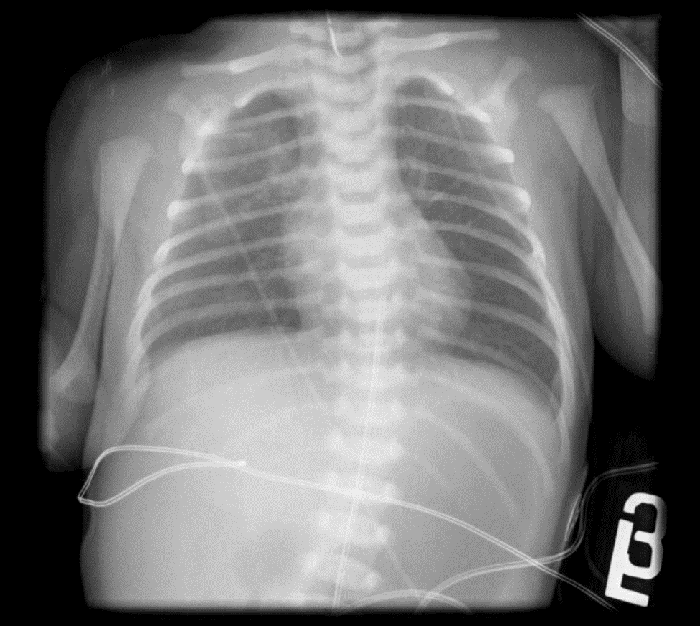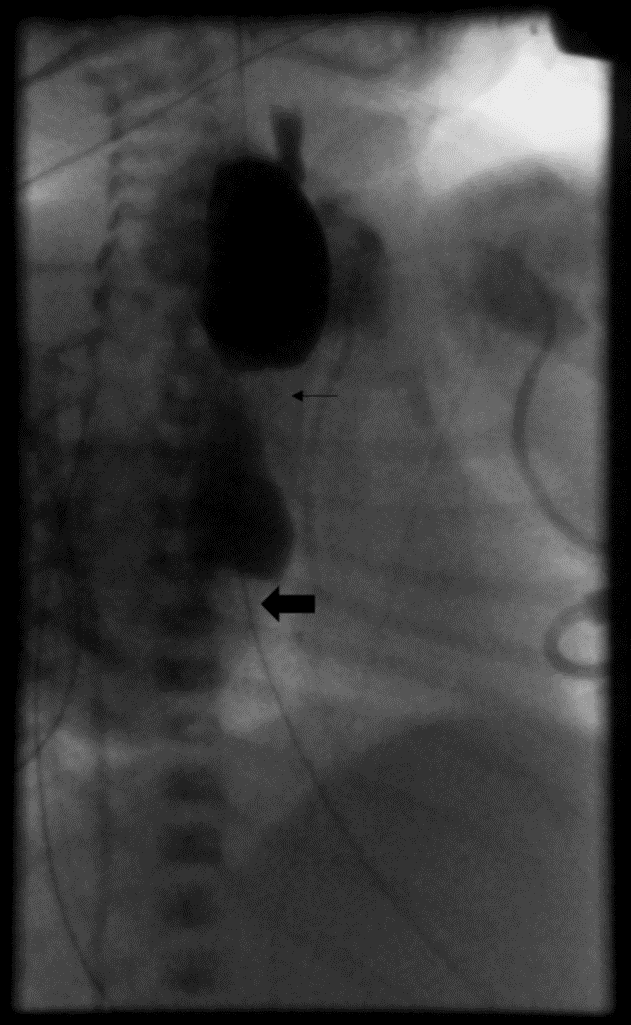Figure 3. Esophagram performed under fluoroscopy shows narrowing at the esophageal anastomosis (small arrow), with a second area of distal stricture (big arrow) with proximal distension. There was very slow passage of a small amount of contrast into the stomach.
Two months later, she electively underwent a resection of the narrowed distal esophagus with primary anastomosis via open right thoracotomy; after dissecting the esophagus above the diaphragm, we discovered a 1.5cm section of narrowed esophagus corresponding to the area seen on UGI. Additionally, a gastrostomy tube was placed in a laparoscopic fashion. Pathology of the resected short segment of esophagus showed a narrow lumen, mucosal reactive changes, and mild chronic inflammation.
Feeding therapy was started and by 4 months of age, she was taking all feeds by mouth. She has undergone three esophageal dilations at age 1.5 years, 2.5 years, and 3 years of age, with endoscopic biopsies each time consistent with eosinophilic esophagitis. She has gained weight appropriately.
Discussion
Roughly half of EA/TEF cases present with other major malformations, most commonly cardiac, skeletal, and anal abnormalities.1-8 Some 5 to 10% of cases have underlying chromosomal abnormalities, most commonly trisomy 18 and trisomy 21. In a study of 463 infants presenting with EA/TEF over an 18-year span, 107 (23%) had two or more defects described in the VACTERL association.8 Of the 107 patients in that cohort, 17 had chromosomal syndromes. Non-VACTERL abnormalities were common in the remaining 90 patients in that study, including an 8.9% incidence of duodenal atresia. In another study of 99 infants presenting with EA/TEF, there were 2 cases of duodenal atresia.7 This is a much higher frequency than the general population, where duodenal atresia has a reported incidence of 1 in 10,000 births.9 The exact pathological association between duodenal atresia and EA/TEF remains unclear, but both conditions are substantially more common in patients with trisomy 21.
Congenital esophageal stenosis has been associated in infants presenting with EA/TEF, separate from narrowing at the esophageal anastomosis. In fact, CES does appear to be diagnosed and repaired earlier in infants with distal CES and EA/TEF compared to CES alone.6 In a retrospective review of 187 children with EA/TEF who underwent postoperative esophagram,10 22 patients (12%) were diagnosed with distal CES, defined by "a narrowing below the anastomosis and above the GE junction with proximal dilation and no evidence of acquired cause of stenosis." The age at diagnosis ranged from 1 week to 10 years; half of the children had clinically significant symptoms such as dysphagia, postprandial emesis, and food/foreign body impaction. The etiology of the stenosis was classified by histology as either a tracheobronchial remnant (most common) or fibromuscular hypertrophy; as in other series, esophageal balloon dilation was either ineffective or resulted in perforation and the authors recommended surgical resection as first line therapy. In addition to EA/TEF and CES, one patient also had duodenal atresia and imperforate anus, one of only two cases of EA/TEF with CES and DA that could be found in our search of the literature.10,11 The esophageal stenosis in our case was present at the time of the first operation on DOL1; accordingly, we felt comfortable with the diagnosis of CES rather than an acquired cause such as reflux, although perhaps in utero reflux due to the duodenal atresia could have contributed.
EE has a reported prevalence of 1/10,000; yet reports of EE associated with EA are not infrequent; once case series reported an incidence of 17%.12 EE was diagnosed months to years following repair and was associated with more reflux symptoms and a higher incidence of fundoplication. Gastroesophageal reflux disease is also common after EA repair, especially in "wide gap" cases requiring more extensive mobilization of the esophagus; in patients refractory to medical therapy, endoscopy with biopsy should be sought to exclude EE.
Conclusions
This case shows an atypical presentation of EA/TEF associated with a distal CES, eosinophilic esophagitis, and a duodenal atresia, and underscores the importance of additional workup for unexpected intraoperative findings.
Lessons Learned
Although esophageal atresia with trachea-esophageal atresia and duodenal atresia were diagnosed from the initial plain film, it was necessary in this case to conduct the surgical repair in stages. Gastric decompression is a priority to prevent rupture of the stomach. Congenital esophageal stenosis is associated with esophageal atresia; if the infant is gaining weight on tube feeds, repair can be done electively at a higher weight.
Authors
Chris T Laird, MD
University of Maryland School of Medicine
Department of General Surgery
Baltimore, MD
Natalie A O'Neill, MD
University of Maryland School of Medicine
Department of General Surgery
Baltimore, MD
Kimberly M Lumpkins, MD, FACS
University of Maryland School of Medicine
Department of Pediatric Surgery
Baltimore, MD
Eric D Strauch, MD, FACS
University of Maryland School of Medicine
Department of Pediatric Surgery
Baltimore, MD
Corresponding Author
Chris Laird, MD
22 S Greene Street
Department of General Surgery, 8th floor
Baltimore, MD 21201
Phone: (414) 266-2000
Email: claird@mcw.edu
Disclosure Statement
The authors have no financial disclosures. No funding or grant support. This report does not contain any personal information that could lead to the identification of the patient.
References
- Depaepe A, Dolk H, Lechat MF. The epidemiology of tracheo-oesophageal fistula and oesophageal atresia in Europe. EUROCAT Working Group. Arch Dis Child. 1993Jan;68(6):743–8. PMCID: PMC1029365
- Neilson IR, Croitoru DP, Guttman FM, Youssef S, Laberge J-M. Distal congenital esophageal stenosis associated with esophageal atresia. J Pediatr Surg. 1991;26(4):478–82. https://doi.org/10.1016/0022-3468(91)90999-A
- Newman B, Bender TM. Esophageal atresia/tracheoesophageal fistula and associated congenital esophageal stenosis. Pediatr Radiol. 1997Nov;27(6):530–4. PMID: 9174027 DOI: 10.1007/s002470050174
- Kim S-H, Kim H-Y, Jung S-E, Lee S-C, Park K-W. Clinical Study of Congenital Esophageal Stenosis: Comparison according to Association of Esophageal Atresia and Tracheoesophageal Fistula. J Pediatr Gastroenterol Nutr. 2017;20(2):79.
- Geneviève D, Pontual LD, Amiel J, Sarnacki S, Lyonnet S. An overview of isolated and syndromic oesophageal atresia. Clin Genet. 2007Feb;71(5):392–9. doi: 10.1111/j.1399-0004.2007.00798.x
- Holcomb GW, Ashcraft KW. Ashcrafts pediatric surgery. London: Saunders Elsevier; 2014.
- Stoll C, Alembik Y, Dott B, Roth M-P. Associated malformations in patients with esophageal atresia. Eur J Med Genet. 2009;52(5):287–90. doi:10.1016/j.ejmg.2009.04.004
- Carli D, Garagnani L, Lando M, Fairplay T, Bernasconi S, Landi A, et al. VACTERL (Vertebral Defects, Anal Atresia, Tracheoesophageal Fistula with Esophageal Atresia, Cardiac Defects, Renal and Limb Anomalies) Association: Disease Spectrum in 25 Patients Ascertained for Their Upper Limb Involvement. J Pediatr. 2014;164(3).
- Choudhry MS, Rahman N, Boyd P, Lakhoo K. Duodenal atresia: associated anomalies, prenatal diagnosis and outcome. Pediatr Surg Int. 2009;25(8):727–30.
- Yoo HJ, Kim WS, Cheon J-E, Yoo S-Y, Park K-W, Jung S-E, et al. Congenital esophageal stenosis associated with esophageal atresia/tracheoesophageal fistula: clinical and radiologic features. Pediatr Radiol. 2010Oct;40(8):1353–9.
- McCann, F., Michaud, L., Aspirot, A., Levesque, D., Gottrand, F. and Faure, C. (2014). Congenital esophageal stenosis associated with esophageal atresia. Dis Esophagus. 28(3), pp.211-215.
- Krishnan U. Eosinophilic Esophagitis in Children with Esophageal Atresia. European J Pediatr Surg. 2015; 25: 336–344.



